Blue White Petals With Long Red Tipped White Stamen
Beautiful Blue Flower Types to Grow at Home or for Your Next Floral Arrangement
When it comes to flowers, blue may not be the first color that springs to mind. That's understandable considering blue pigments are not common in the plant world. Since true blue flowers can be rare, they are highly sought-after and make an excellent option for gifting or growing in your garden. And as it turns out, there are more varieties of blue flora than you may think. Read on to discover 50 of our favorite types of blue flowers. We'll discuss everything from their unique characteristics to what they've symbolized throughout history.
The Meaning and Symbolism of Blue Flowers
Many people associate the color blue with a feeling of calm. It's a shade that soothes whether you're eyeing the grey-blue waves of the ocean or the deep hues of the night's sky.
Due to their color, blue flowers can bring various emotions to the surface. The color blue has proven to bring about feelings of relaxation and comfort and even decrease anxiety.
Blue flowers have adopted various meanings throughout history, from Ancient Egypt to the Roman Empire and beyond. To ancient Egyptians, the color blue signified royalty and the elite class of pharaohs. On the other hand, the Romans associated the color with the Celts, who wore blue war paint when they went into battle.
Additionally, the blue flower was a primary source of inspiration and social change in the 18th century. During Europe's Romanticism movement, blue flowers were the symbol of a flourishing society.
Over the years, blue flowers have come to symbolize strong emotions such as love, desire, and the pull toward grand ambitions. Blue flowers can also represent hope, beauty, and creativity.
Blue Flowers in Art and Literature:
The author H.H. Boyesen explained that the blue flower was a "sacred symbol… meant to symbolize the deep and sacred longings of a poet's soul."
We can see examples of this from Joseph Freiherr con Eichendorff's poem titled The Blue Flower to C.S. Lewis's use of blue flora as a symbol of longing. Blue flowers even appear as a symbol in George R.R. Martin's series A Song of Ice and Fire, also known by the television series Game of Thrones.
Today, the color blue continues to represent relaxation and serenity. Blue flowers make a great gift for various occasions, from a baby's birth to an anniversary. They also work well as an expression of sympathy, as they can symbolize peace and a connection to the divine.
For more, see our essential guide to the meaning, symbolism, and cultural significance of blue flowers.
50 Popular Types of Blue Flowers
Now, let's take a look at 50 popular types of blue flowers. These examples will show you the range of options when selecting blue flowers for gifting or growing in your garden. Choose a few of your favorites, expand your knowledge, and explore unique flora in various shades of the color blue.
1. Morning Glory (Ipomoea tricolor)

Morning glories, (Ipomoea tricolor or Ipomoea indica) are blue flowering plants that belong to the Convolvulaceae family. As you may have guessed, this species gets its name from its early morning blooms.
While some morning glories are annual plants, most are perennial. You'll also find moonflowers in this species, a unique variety of plants that bloom at night.
What's more, morning glories grow quickly and are known for their bold colors. This flower can grow in many hues, including blues, purples, and pinks.
2. Blue Anemone (Anemonoides oregana)

The blue anemone, or Anemonoides oregana, is a member of the buttercup family. A common nickname for this blue beauty is the blue windflower. The species is native to the forests of several states in North America, including Oregon and Washington.
Typically, the blue anemone flower thrives below the elevation of 7,000 feet. When it blooms, there are no petals. Instead, the flower has several sepals that sprout alongside as many as 75 miniature stamens. The flower is usually blue or purple, but it can also have red, pink, white, or bi-colored blooms.
3. Hydrangea (Hydrangea macrophylla)

The blue hydrangea, or Hydrangea macrophylla, is a deciduous shrub native to Japan. The flower is characterized by expansive heads of blue flowers that bloom in the summer months. `This species grows outward in all directions, creating round bursts of bright blue blooms.
Additionally, the so-called bigleaf hydrangea blooms pink in the fall. The leaves can reach around six inches long, making the hydrangea plants a striking choice for landscaping or arranging in a bouquet.
4. Geranium (Geranium)
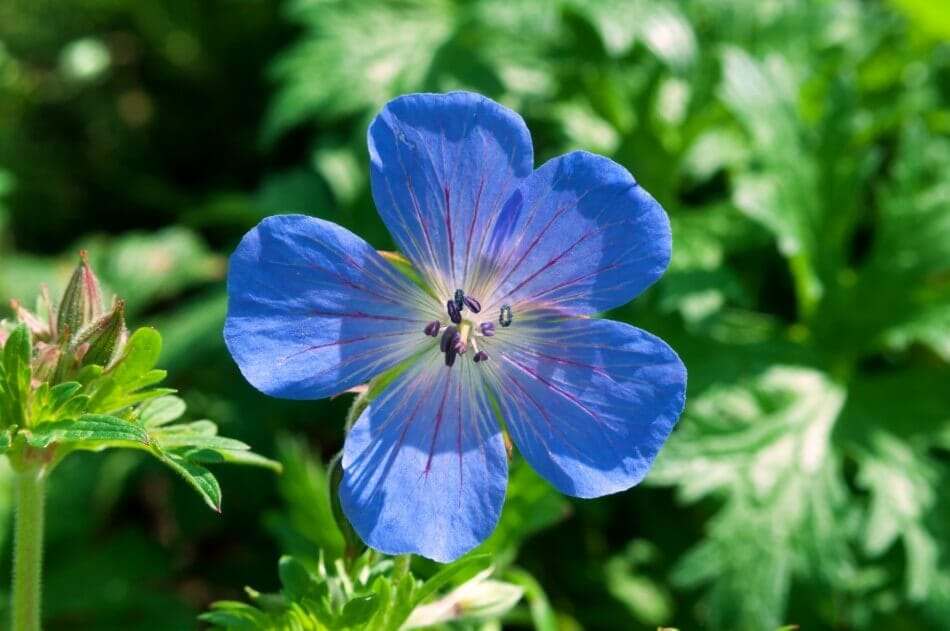
Geraniums are a genus of various plants that are primarily found in mountainous areas and around the Mediterranean. The flowers have five petals and bloom in shades of blue, purple, pink, or white.
Some members of the geranium genus make a great winter-hardy addition to a garden. Others are grown for pharmaceutical purposes. A few hybrid cultivars of Geranium have earned the Royal Horticultural Society's Award of Garden Merit.
5. Clematis (Clematis)
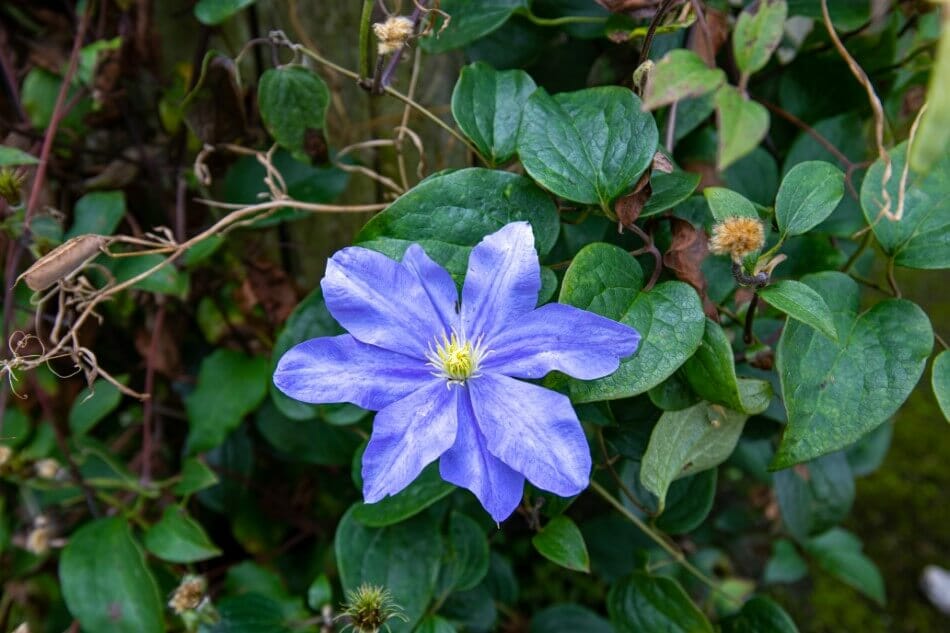
Clematis is a genus of around 300 species of flowers belonging to the buttercup family Ranunculaceae.
Flowers in this genus have adopted several names over the years, from traveler's joy to vase vine and leather flower. These names reflect the characteristics of the specific flower or the location where it is grown.
The name Clematis comes from the Ancient Greek word, which translates to climbing plant. The climbing vines or lianas of the flower give it a magical appearance. This flower grows best in full sun and moist, well-drained soil.
For more, see our expert guides to growing Clematis Montana, and Clematis Nelly Moser at home.
6. Felicia Daisy (Felicia amelloides)

Felicia amelloides, or the Felicia daisy, belongs in the daisy family. This is a perennial, evergreen plant grown primarily for ornamental purposes.
The Felicia daisy is native to South Africa, but people began growing it in Europe in the 18th century. The flower's colorful heads grow from long, dark green stems that can reach around 19 inches in height. This daisy's soft blue petals complement the yellow florets at the center of the flower.
7. Bluebells (Hyacinthoides non-scripta)

Bluebells, or Hyacinthoides non-scripta, are bulbous perennial plants. The species gets its common name from the bell-like appearance of its blooms.
Bluebells have thin stems of around 20 inches that produce a series of bell-shaped flowers. Many people travel to bluebell fields in the UK and northern Spain to see this unique flower growing wild in its natural habitat.
In the Victorian language of flowers, bluebells symbolized humility, gratitude, and everlasting love. Today, the flower is grown primarily for ornamental purposes. However, in the past, people used the plant's sap to bind books or glue feathers to arrows.
8. Native Blue Lupine (Lupinus)

The native blue lupine, or Lupinus, is a flowering plant genus that belongs to the Fabaceae legume family.
Much like bluebells, Lupinus flowers can form a sea of blue when they grow wild in fields. The flowers are native to North and South America. However, they are cultivated in many countries for food and ornamental purposes.
This plant's blooms grow in whorls around a solitary stem, with individual flowers that are pea-like in shape. This flower's curious form has led to the nicknames quaker bonnets and bluebonnets.
9. Forget-Me-Nots (Myosotis scorpioides)

Myosotis scorpioides, or Forget-Me-Nots, are perennial flowering plants that belong to the borage family, or Boraginaceae.
This plant is native to Asia and Europe. However, it has made its way to many countries like the United States and the UK.
Forget-Me-Nots grow best in damp habitats like bogs and streams. The flowers may even form lilypad-like rafts that float along the water's surface.
This plant can grow to a height of around 27 inches. Its small flowers start off pink before blooming into a vibrant shade of blue.
10. Iris (Iris sibirica)

Iris flowers are part of the Iris genus, which also go by the Siberian iris or Siberian flag. This species is native to many parts of Eastern Europe and is cultivated in parts of Central Asia.
This attractive blue flower has a tall stem that resembles a blade of grass and typically grows two to five bright purple-blue petals. While some of the petals stand up, others arch downward to create an interesting visual.
11. Brunnera (Brunnera macrophylla)

Brunnera macrophylla, also known as the great forget-me-not or heartleaf, is a flowering plant species native to the Caucasus region that spans Europe and Asia.
This herbaceous perennial can grow to around a foot tall and features a series of small and delicate blue petals. The flowers resemble forget-me-nots in appearance, and they bloom during the months of spring.
Often, the Brunnera flower is used as ground cover in areas with enough shade and moisture for the plant to thrive. Interestingly, genetic evidence indicates that this species may represent the ancient flora that grew in forests around the Black Sea.
12. Globe Thistle (Echinops)

The globe thistle, or Echinops, is a flowering plant genus belonging to the Asteraceae family, or the daisy family. The plant is native to Europe, Africa, and parts of Asia.
Globe thistles get their name due to their spherical shape. Their blooms resemble a firework, with a series of blue or purple spines that grow outward in a unique and textured pattern.
Some of the varieties within the species include Echinops bannaticus, Echinops exaltatus, and Echinops niveus. You'll find these species growing anywhere from fields in Japan to wild patches along the coastline.
13. Lungwort (Pulmonaria 'Blue Ensign')

The Pulmonaria 'Blue Ensign' is a cultivar of Lungworts from the genus Pulmonaria.
The flower is native to both Europe and western Asia. These colorful flowers have rough hairs across their leaves, which gives them a bristly texture.
Curiously, the origin of the name comes from the Latin word 'pulmo,' which means lung. The leaves of this plant were once thought of as a symbol for diseased lungs.
14. Himalayan Blue Poppy (Meconopsis betonicifolia)

The Himalayan blue poppy, or Meconopsis betonicifolia (also called Meconopsis baileyi), is a flowering plant species that belongs to the Papaveraceae family.
This flower has large flowers that bloom in a shade of powder blue. This flower got its alternative scientific name, Meconopsis baileyi, in 1912. It was named for Frederick Marshan Bailey, an officer in the British army.
You'll find the Himalayan blue poppy growing wild in fields around its native Tibet. It also grows wild in the United States, in coastal areas around California and New England.
15. Lungwort (Pulmonaria officinalis)

Pulmonaria officinalis is a plant that belongs to the genus Pulmonaria, and goes by many other names, like Mary's tears and Our Lady's milk drops.
This lungwort was named for its medicinal properties. Christian doctors believed that the flower's similar appearance to the human lung meant it could treat coughs and other illnesses affecting the chest.
This lungwort has long, green leaves that have a bumpy and hairy surface. The five petals start out red before blooming into regal blue and purple tones.
16. Columbine (Aquilegia)
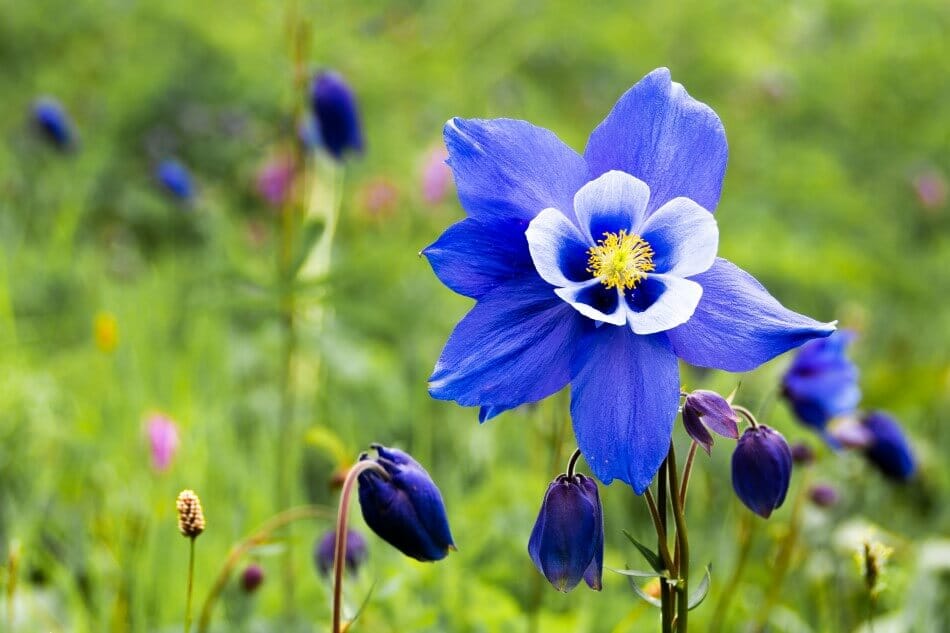
Columbines, or Aquilegia, are native in the Northern Hemisphere. The so-called granny's bonnet grows primarily for horticultural purposes.
Once in full bloom, this flower's petals have been said to resemble an eagle's claw. This is why the plant's name is Aquilegia, which is derived from the Latin word 'aquila,' meaning eagle.
The Colorado blue columbine is the official flower of the US state of Colorado. The flower has represented many qualities throughout history, including aspiration, peace, and strength.
17. Flax (Linum usitatissimum)

Flax, or Linum usitatissimum, is a flowering plant that belongs to the Linaceae family. Typically, the flower blooms with five pale blue petals, though some varieties are white, yellow, or red.
Linum usitatissimum is cultivated around the world for its many uses. Its cultivation dates back centuries, and the plant was even popular thousands of years ago in ancient Egypt, the Roman Empire, and beyond.
If flax sounds familiar, it may be because fiber-rich flax seeds are a food item available in supermarkets. The linseed oil the flower produces is also popular for painting or varnishing wood. Additionally, flax is used to make linen for sheets and clothing.
18. Bluestar (Amsonia tabernaemontana)

Amsonia tabernaemontana, or the eastern bluestar, is a flowering plant belonging to the Apocynaceae family. The flower is native to North America and can be found in the central and eastern regions of the continent.
Bluestar flowers were named for their shape. The plant's blooms are small and delicate in appearance, with five petals that resemble a star. Generally, this species won't grow taller than two or three feet.
Despite their small size, these flowers come together to create a striking visual. They form pale blue clusters that look great growing in a garden.
19. Salvia (Salvia)

Salvia is a genus of plants that belongs to the Lamiaceae family, or the sage family. The Salvia genus is found in the Americas, the Mediterranean, and parts of Asia.
This plant is named after the Latin word 'salvere,' which is a verb indicating good health. This is because the flower is known to have several healing properties.
Within the species, there are perennial, biennial, and annual plants consisting of many blue or almost purple flowers. The common traits among these plants include angled stems and toothed or divided leaves.
20. Blue False Indigo (Baptisia australis)
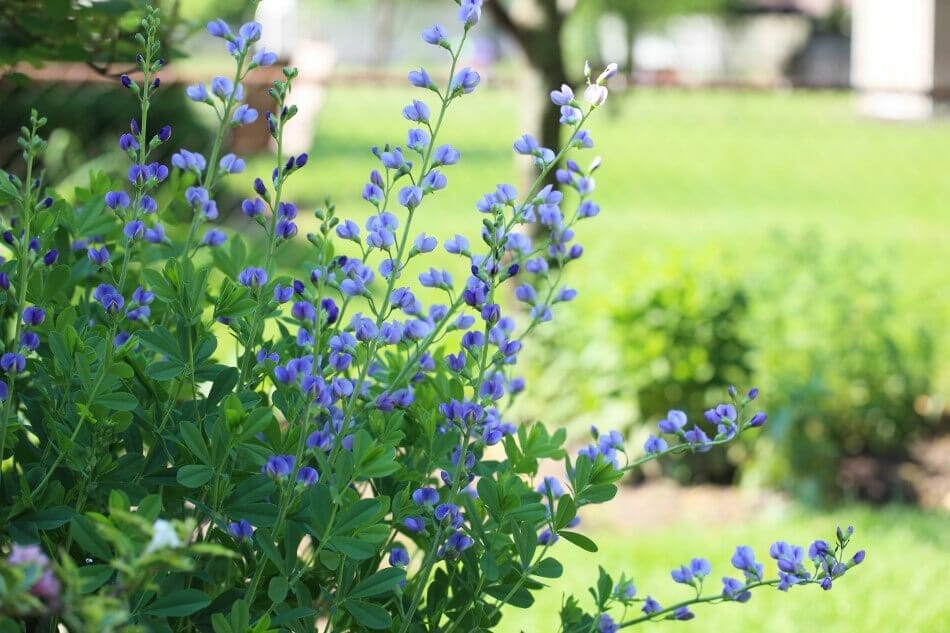
Blue false indigo, or Baptisia australis, is a flowering plant that belongs to the Fabaceae family, or the legume family.
The plant is native to most parts of North America and usually grows at the edge of forested areas. Like bluebells, the blue false indigo's stems grow like a tall blade of grass. The blooms grow vertically along the stem in a deep purple-blue tone.
American Indian tribes like the Cherokees have used this plant throughout history to make blue dyes for textiles. They have also used the seeds to make rattles for children.
21. Harvestbells (Gentiana saponaria)

Harvestbells, or Gentiana saponaria, are also known as soapwort gentians. The flower grows to be between one and two feet tall and belongs to the Gentianaceae family.
This flowering plant is native to North America. It grows around the southern Great Lakes from New York to Wisconsin and southern areas like Florida and Texas.
Harvest bells grow best in sandy soils and bloom from September into November. The plant prefers full sun to partial shade and looks great growing in the garden along with other autumnal blooms.
22. Blue Delphiniums (Delphinium)

The blue delphinium is a flowering plant that belongs to the genus Delphinium. This genus belongs to the Ranunculaceae family and has around 300 different species that are native in the mountains of tropical Africa and parts of the Northern Hemisphere.
Many of the species in the Delphinium genus are blue. Blue delphinium cultivars including 'Centurion Sky Blue,' 'Clifford Sky,' and 'Galileo' have all won the Royal Horticultural Society's Award of Garden Merit.
The name delphinium comes from the Ancient Greek word 'delphinion,' which translates to dolphin. This is because the flower's petals have a dolphin-like shape.
23. Blue corydalis (Corydalis flexuosa)

Blue corydalis or Corydalis flexuosa is a flowering plant native to woodlands and mountainous parts of China. It is a member of the Papaveraceae along with poppies and hundreds of other species.
Blue corydalis blooms have pale blue two-lipped flowers that cluster around white throats. The plant thrives in partial shade and grows dormant in the summer months.
A few cultivars of blue corydalis have earned the Royal Horticultural Society's Award of Garden Merit. These include the 'Blue Panda' and 'Purple Leaf' cultivars.
24. Cornflower (Centaurea cyanus)

Cornflower, or Centaurea cyanus, is a flowering plant that belongs to the Asteraceae family. Native to Europe, the plant was once considered a weed growing in cornfields, which is where it got its name.
Interestingly, the plant is now considered endangered in its native environment due to the overuse of herbicides. However, it has been naturalized in other parts of the world. This plant is used for everything from food to anti-inflammatory medicines.
The blue cornflower was once a national icon representing Germany. It also appears in folklore as a symbol for young men in love.
25. Grape Hyacinth (Muscari)

The grape hyacinth, or Muscari, is a spring-blooming flower that belongs to the Asparagaceae family. This hyacinth look-alike is native to Europe and gets its scientific name from the Greek word muschos, meaning musk.
The reference to grapes comes from the way this flower's blooms form along its stems. The blue-purple petals grow in a series of small heads that cluster together, resembling a bunch of grapes.
26. Sweet pea (Lathyrus odoratus)

Sweet pea, or Lathyrus odoratus, is a fragrant flowering plant that belongs to the Fabaceae family, or the legume family.
This climbing plant is native to the Italian island of Sicily and the Aegean Islands. Its leaflets are attached to a tendril that wraps around nearby plants, buildings, or walls.
This plant can grow in a pastel blue-purple color. The species is well known in floristry, and over 50 cultivars have earned the Royal Horticultural Society's Award of Garden Merit.
27. Blue Larkspur (Consolida)

Consolida is a plant genus in the Ranunculaceae family that is commonly known as larkspur within seed catalogs. This genus is native to areas of western Europe, Asia, and the Mediterranean.
Despite its classification, studies have shown that the larkspur is closely related to the Delphinium genus. However, while delphinium flowers have four different petals, the consolida flower has just one.
The blue larkspur has deep blue, vertical blooms that are a common sight in gardens. It is also popular as a cut flower arranged in bouquets.
28. Blue cosmos (Cosmos bipinnatus)

The blue cosmos is a member of the species Cosmos bipinnatus, which belongs to the daisy family. It is native to the Americas and sometimes called the Mexican aster.
This flower is a common addition to gardens, as it is attractive to both humans and pollinators. The blue cosmo adds a unique focal point to gardens while inviting honey bees, monarch butterflies, and pollinating birds.
Like other cosmos, the blue cosmo may symbolize innocence, harmony, or peace. The flower creates a sense of tranquility, similar to its relative, the daisy.
29. Chicory Flower, Blue Dandelion (Cichorium intybus)

Cichorium intybus, sometimes called the chicory flower or the blue dandelion was first cultivated in the 17th century. However, it is native to North Africa, western Asia, and Europe and has roots in ancient Egypt and Rome.
The flower has a fascinating culinary history as an additive or substitute for coffee. People have also used the plant as a sweetener or prebiotic.
The chicory flower blooms in the summer and fall in Europe, North America, China, and Australia.
30. Hibiscus (Hibiscus syriacus)

Hibiscus syriacus is a flowering plant species that belongs to the Malvaceae family, or the mallow family. While it's native to areas of southern China, the plant can be found all over Asia.
The name syriacus came about due to the flower's associations with Syria, as it was commonly grown in Syrian gardens. The Rose of Sharon, as it's sometimes known, has become popular in North America and the UK.
This plant grows as a deciduous shrub. It has four large leaves which surround prominent white or yellow stamens.
31. Lily of the Nile (Agapanthus)
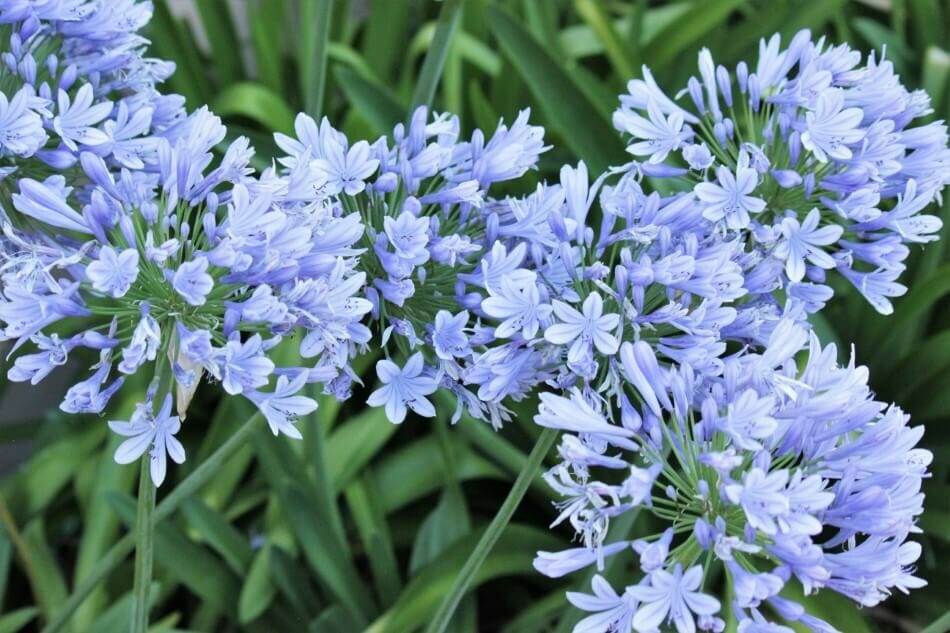
Lily of the Nile, or Agapanthus, is the only genus in the Agapanthoideae family. The genus gets its name from the Greek words 'agape,' meaning love, and 'anthos,' meaning flower. This flowering plant is native to areas of southern Africa.
The Lily of the Nile grows green stems and pale blue blooms that expand outward in all directions. The plant enjoys full sunlight or partial shade and moist, well-drained soil.
32. Gentian Flower (Gentiana)

The Gentian flower belongs to the Gentiana genus and Gentianaceae family. This flower grows in a deep, bold shade of blue, with blooms that have a trumpet-like shape.
This flower's azure petals create a spectacular focal point for any garden space. You'll find it growing everywhere from Europe and the Americas to alpine regions in Asia.
Interestingly, the gentian flower's root is commonly used to make different types of drinks. It is a common ingredient in bitters, and is even used in the soft drink Moxie and Italian liqueur Aperol.
33. Virginia Bluebells (Mertensia virginica)
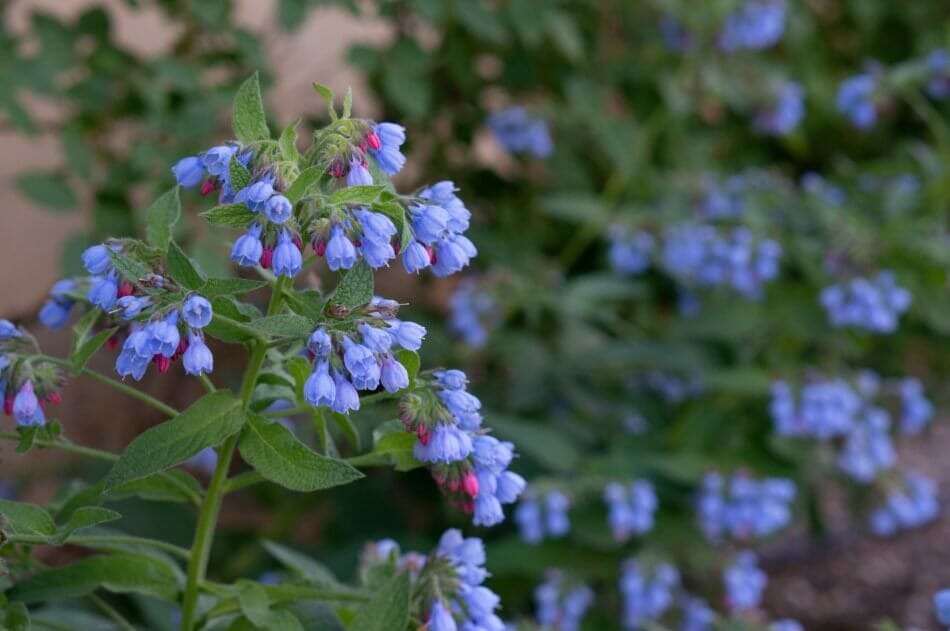
Virginia bluebells, or Mertensia virginica, are native to North America. These flowers bloom in spring, revealing pink buds that transform into tubular flowers ranging from deep-blue to sky blue in color.
You may find this flower growing wild in woodlands or river floodplains. You can also grow it in a wildflower garden alongside other spring-blooming flowers.
Virginia bluebells attract pollinators like butterflies and bumblebees. Its blooms will last around three weeks around those spring and summer months.
34. Speedwell (Veronica)
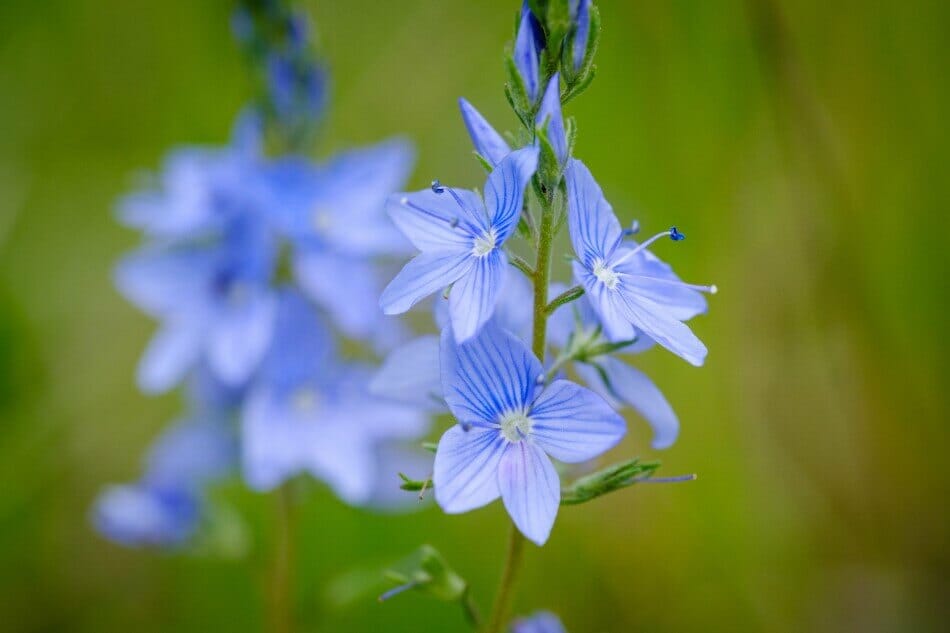
Veronica is the largest genus within the Plantaginaceae flowering plant family. This genus is also called speedwell or bird's eye.
The Veronica genus has many different types of blue flowers. Some grow as ground cover, while others contribute a striking, cone-shaped appearance to landscaping and wildflower gardens.
Most species in the Veronica genus reside in the Northern Hemisphere. Experts in Austrian medicine have used the root of this plant to make teas to help with disorders of the nervous system, metabolism, and other ailments.
35. Desert Bluebells (Phacelia campanularia)
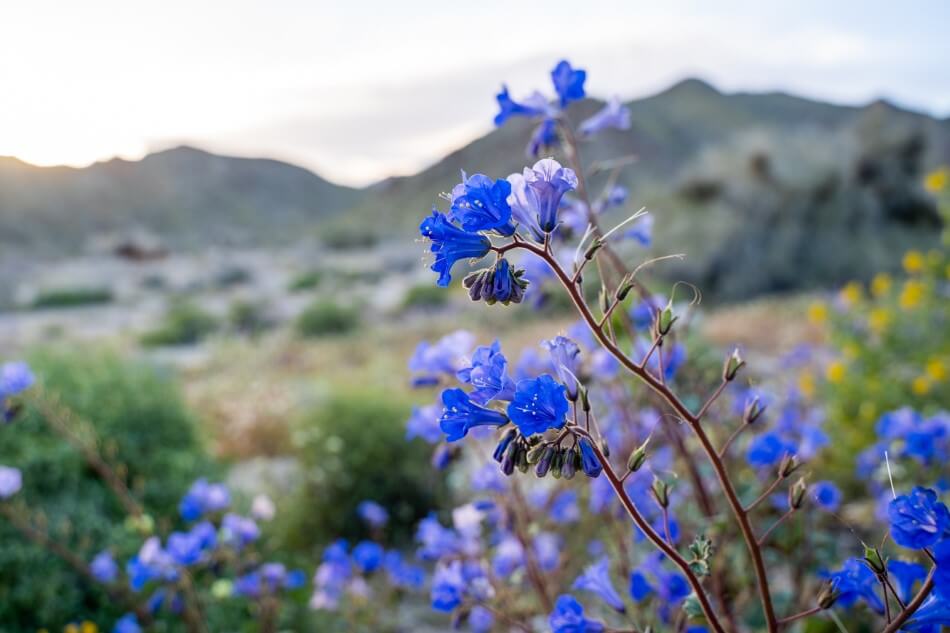
Desert bluebells, or Phacelia campanularia, are a flowering plant species in the Boraginaceae family. You may have heard of this flower by the names desert scorpionweed or California-bluebells.
This is because the Phacelia campanularia flower grows primarily in California and deserts like the Mojave and Sonoran. It also grows as an introduced species in other parts of the world.
This flower's rounded petals are a rich, deep blue tone, with long white-tipped stamens at the center. The desert bluebell grows well in the wild and as an ornamental plant.
36. Scabiosa (Scabiosa)

Scabiosa is a genus that belongs to the Caprifoliaceae flowering plant family, or the honeysuckle family. Plants in the Scabiosa genus are native to Asia, Europe, and Africa.
The name scabiosa stems from the word 'scabious,' which refers to old medicinal practices which involved using the flower to treat scabies.
These blooms are also commonly known as pincushion flowers. They have fringed, sprawling leaves that form a round head at the end of the stem.
37. Love in a Mist (Nigella damascena)

Love in a Mist, or Nigella damascena, belongs to the Ranunculaceae family, or the buttercup family.
The plant's romantic name points to its origin in the south of Europe. It grows in a lacy bush of foliage, which gives it a mist-like appearance.
The plant can bloom in various colors, including blue, white, pink, and purple. It has been popular as a garden plant dating back to the Elizabethan era.
38. Rose of Sharon

Rose of Sharon refers to several flowering plant species, particularly a deciduous flowering shrub in the mallow family. The name Rose of Sharon is a biblical reference, but the exact flower it refers to remains unclear.
Some flowers commonly associated with the name include the Hypericum calycinum and Hibiscus syriacus.
Out of the flowers associated with this name, the Hibiscus syriacus is the species known for its vibrant, blue petals.
39. Lobelia (Lobelia)

Lobelia is a genus that encompasses a wide variety of flowers that thrive in warm or tropical climates.
Lobelias can be annual or perennial shrubs that come in many colors, including a deep shade of purple-blue. Interestingly, it seems as if no two lobelias are alike, as each flower in the genus has completely unique characteristics that separate it from the rest.
This genus is a popular option among gardeners, as it produces beautiful, full blooms in a range of bold colors.
40. Birdbill Dayflower (Commelina dianthifolia)

The Bird Bill dayflower, or Commelina dianthifolia, is a perennial herb belonging to the Commelinaceae spiderwort family. It grows primarily in the American Southwest and northern Mexico.
This plant is notable for its small blooms, each flower with three blue petals and green sepals. It gets its name dayflower because its blooms open at dawn and close up around the afternoon.
41. Blue Monkshood (Aconitum napellus)

The blue monkshood, or Aconitum napellus, is a flowering plant in the Ranunculaceae family. Also known as wolfsbane or aconite, this toxic plant is one you'll have to admire from afar, as it is poisonous to touch and consume.
You can recognize the blue monkshood by its tall stem and blue-purple bell-shaped blooms. The 'Spark's Variety' cultivar has received the Royal Horticultural Society's Award of Garden Merit.
42. Poor Man's Weather Glass (Anagallis arvensis)
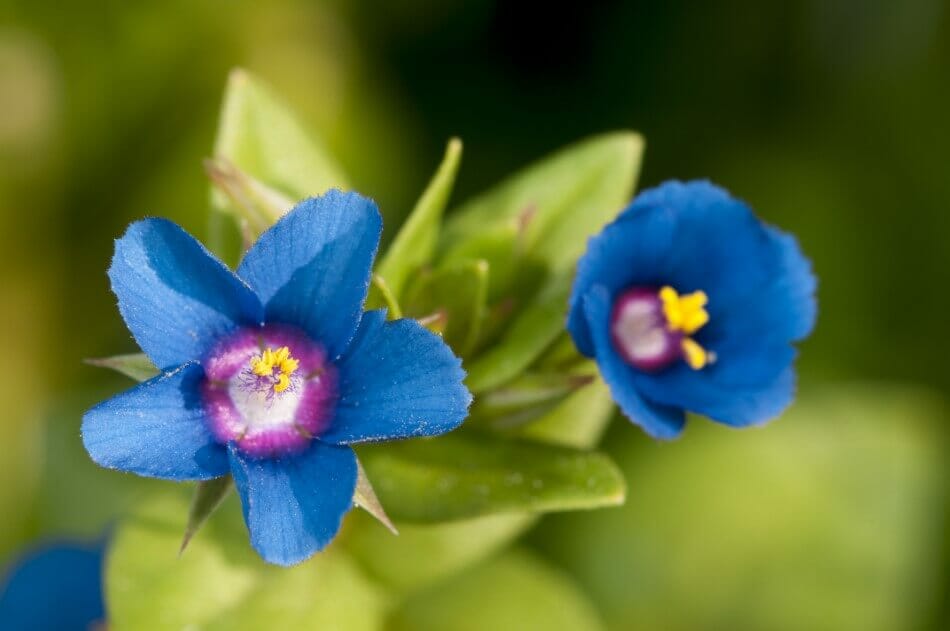
Anagallis arvensis, sometimes called the poor man's weather glass or shepherd's clock, is an annual plant that blooms in bright shades of pink or blue.
It belongs to the Primulaceae, or the primrose family, and is native to Europe, North Africa, and Western Asia. However, it has since been introduced to many other parts of the world.
This flower blooms with five round, blue petals around a violet purple center and several yellow stamens. It grows wild along roadsides but has also been cultivated for medical and agricultural purposes.
43. Siberian Squill (Scilla siberica)

The Siberian squill, or Scilla siberica, is a species of flowering plant that belongs to the Asparagaceae family. Interestingly, the plant is not native to Siberia. Instead, it is native to Turkey, the Caucasus region, and parts of southern Russia.
Otherwise known as the wood squill, this plant is a bulbous perennial. It blooms at the start of spring, producing masses of beautiful blue flowers. The flower grows to a height of around four to eight inches tall.
44. Bluecrown Passionflower (Passiflora caerulea)
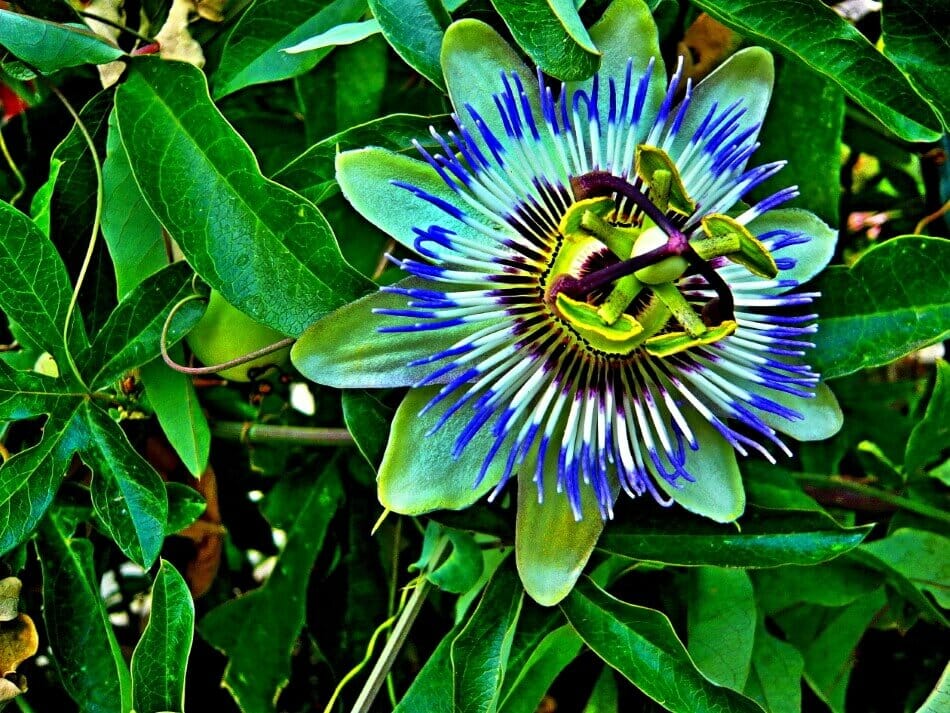
The bluecrown passionflower, or Passiflora caerulea, is a flowering plant that's native to South America.
The tendril vine is often deciduous, though it can also be semi-evergreen, and reach around 33 feet in length. The plant's blooms open up into a mesmerizing mandala of blue and white fringe and pale petals.
The bluecrown passionflower's vines latch onto nearby trees for support. This plant also produces a fruit that can be eaten, though it is favored in teas as it contains trace amounts of hydrogen cyanide.
45. Blue Orchids (Orchidaceae)

There are roughly 28,000 species of orchid across 763 genera, making it one of the largest flowering plant families. They usually take their place high up in the trees with free-hanging roots.
You may have come across a blue orchid known as Blue Mystique. These stunning flowers gain their blue color from a dying process, meaning they are not truly blue. Once the blue flowers drop, they will grow back to be their original white color.
However, that doesn't mean blue orchids don't exist. Several rare orchids, such as the Blue Vanda orchid, are truly blue but very difficult to find.
46. Starflower (Borago officinalis)

The starflower, or Borago officinalis, is native to the Mediterranean. However, it can be found in many countries around the world.
This is a great flower to grow if you're based in Europe due to favorable conditions for cultivation. The starflower's leaves are edible, and its seeds can be converted into borage seed oil.
The flower itself has pointed petals with a blue-purple hue, though you can also find it with white blooms.
47. Lead Plant (Ceratostigma plumbaginoides)
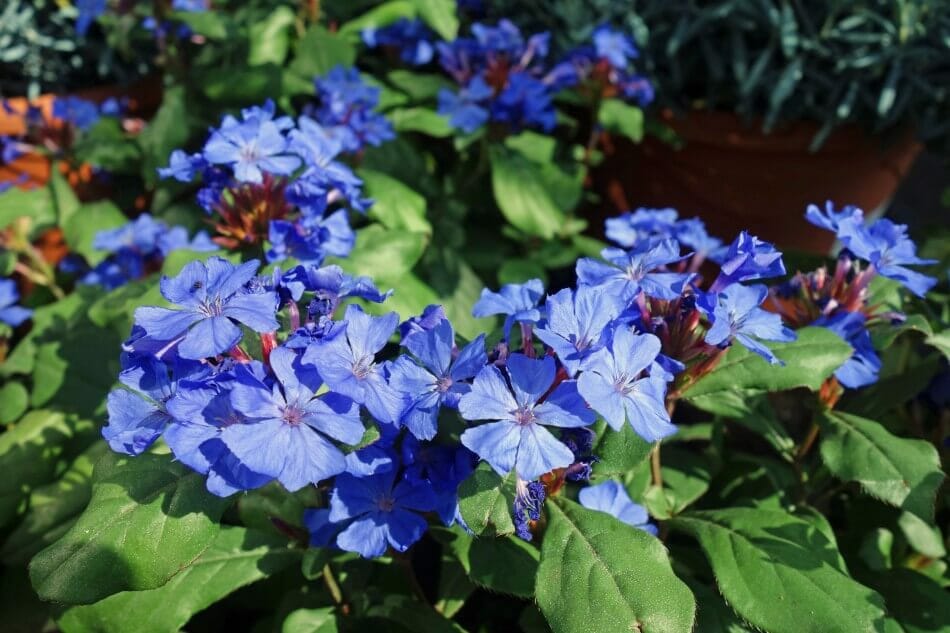
The lead plant, or Ceratostigma plumbaginoides, belongs to the Plumbaginaceae family, or plumbago family, which is native to Western China.
The lead plant is a herbaceous perennial with small blue leaves. It doesn't bloom until the end of summer or the beginning of autumn.
This species enjoys full sunlight and will grow well in well-drained soil of almost any quality. This is a tolerant plant that can gardeners grow for ornamental purposes. It can also aid in erosion control.
48. Mediterranean sea holly (Eryngium bourgatii)
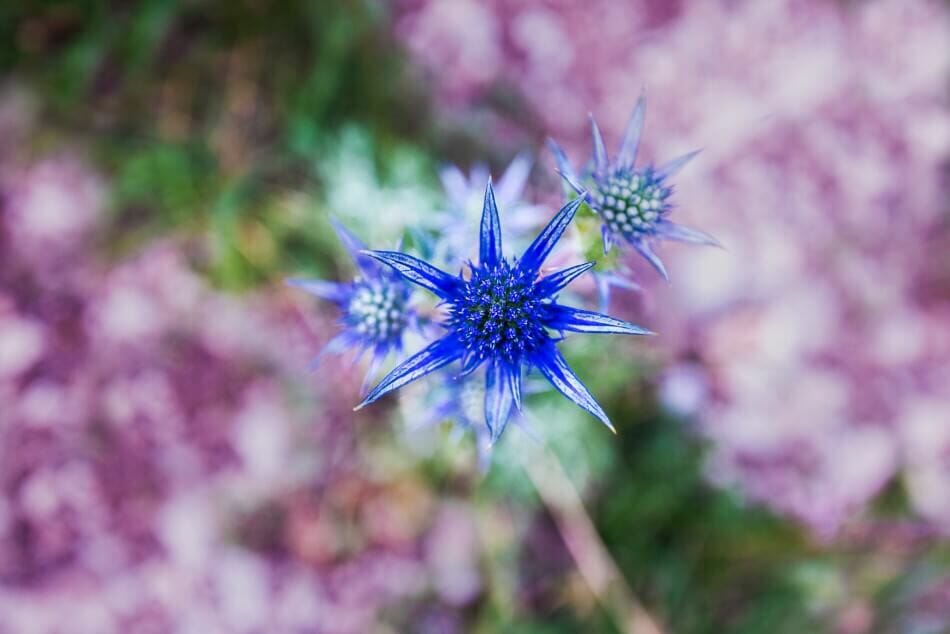
Mediterranean sea holly, or Eryngium bourgatii, is a flowering plant species in the Apiaceae family. The plant is native to several countries such as France, Spain, Morocco, Turkey, and Lebanon.
The herbaceous perennial has a spiky appearance, with a rounded flowerhead and several spiny leaves. The plant's scientific name bourgatii comes from a French doctor called Bourgat who collected plants in the Pyrenees in the late 18th century.
49. Glory-of-the-snow (Chionodoxa)

Glory-of-the-snow, or Chionodoxa, is a perennial flowering plant in the Asparagaceae family. This plant has small bulbous flowers that bloom in colors like blue, white, and pink.
As the name would suggest, this species thrives in the snow, mostly in the eastern Mediterranean areas of Crete, Turkey, and Cyprus. The plant tends to flower in alpine zones once the snow begins to melt at the start of spring.
50. Blue-Eyed Grass (Sisyrinchium demissum)

Blue-eyed grass, or Sisyrinchium demissum, is a perennial wildflower that belongs to the iris family.
Native to North America, the flower has a grouping of blue or purple petals at the top of a long, thin stem. The plant grows to around one foot in height and features a yellow eye in the center.
This is a popular garden flower as its blooms provide a nice contrast to the green grassy stems.
51. Balloon Flower (Platycodon grandiflorus)

These perennials have spherical inflated blooms that burst into a blue star shape, hence the name balloon flower. The flowers are a purplish-blue pastel color that look wonderful in cottage gardens.
Part of the Campanulaceae family, Balloon flowers are related to a number of popular ornamentals. They are remarkably easy to care for and attract a wide range of pollinators to the garden.
52. Impatiens (Impatiens namchabarwensis)
Also known as Blue Diamond Impatiens, this annual is a rare blue flower native to the Himalayas. Only recently discovered in 2003, it grows only in a small region of the mountains.
Beloved for their true blue color, these plants require the best care to thrive. They grow from 12-24 inches tall. Impatiens flower from spring through to late summer, dying back when the weather cools.
53. Tweedia (Oxypetalum coeruleum)

Native to South America, this flowering plant has delicate pastel blue blooms emerging from slivery-green foliage. The star-shaped flowers are great fillers for bouquets due to their long-lasting nature.
Also known by the scientific name Tweedia caerulea, this is another plant that has won the Royal Horticultural Society's Award of Garden Merit.
54. Blue Violet (Viola sororia)

Featuring stunning blue-purple flowers on short stems, this perennial plant is native to North America. Part of the Violaceae family, they grow in moist habitats and thrive in the shade.
As the flowers are edible, these plants have been used throughout history as food and for medicine. Historically, they have been used to treat headaches, colds, and sore throats.
55. Empire Blue Butterfly Bush (Buddleja davidii 'Empire Blue')
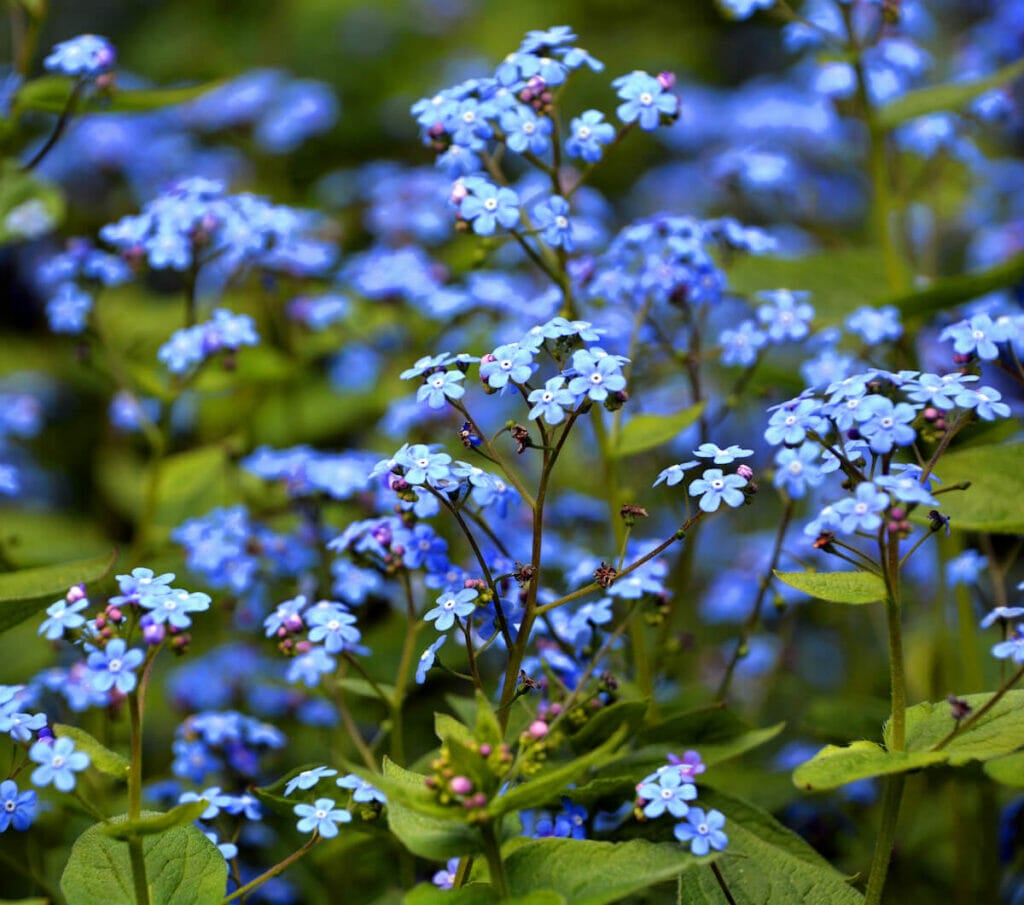
Empire Blue Butterfly Bush is a deciduous shrub sporting large light blue to violet flowers with a sweet scent. The flowers are clustered together on long branches, intensifying the scent and filling the air in your garden.
The long-lasting blooms are perfect for flower arrangements or as gifts. They also attract many pollinators to the garden with their scent and lovely blue color.
Wrapping Up
Blue flowers bring a sense of calm while offering symbolism ranging from hope and optimism to ambition and desire. They add a beautiful focal point whether placed in a garden or arranged in a vase.
If you're looking for an easy way to bring a splash of color to your garden, then you can't go wrong with a deep blue flower or two. Grow them at home or give them as a gift to help those around you enjoy the peace that blue flowers have to offer.
Blue Flower FAQs
What do flower colors symbolize?
Flower color meaning and symbolism date back to ancient times and have evolved over time to convey sentiments and feelings that words alone could not portray. Today, both the flower type and inherent colors contribute to the meaning and symbolism of a particular bloom.
What is the rarest blue flower?
Blue-fringed daisies and Blue Gentian are considered among the rarest of blue flowers.
What is the meaning and symbolism of blue flowers?
In floriography, blue symbolizes affection, desire, love, inspiration, trust, purity, tranquility, or sympathy.
What are blue flowers used for?
Blue flowers are associated with intimacy and love which makes them a beautiful choice for Valentine's Day or a romantic gift. The 10th wedding anniversary is associated with silver and blue, making blue blossoms a natural choice for this important milestone. Blue flowers are also popular for wedding bouquets and centerpieces. Blue may also be associated with sympathy.
What does the blue rose symbolize?
The blue rose represents mystery and is often used as a way to tell someone that they're unique and extraordinary.
overstreettherreck.blogspot.com
Source: https://www.petalrepublic.com/types-of-blue-flowers/
0 Response to "Blue White Petals With Long Red Tipped White Stamen"
Post a Comment